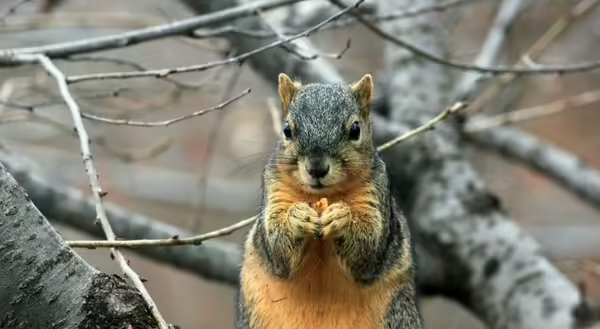
Proactive strategies can lessen the extent of wildlife damage to your gardens through fall and winter.
Once the ground is frozen, rabbits will have fewer places to take shelter or hide, and will forage for food a lot closer to the protection of their winter home. They will go for anything green but once that is gone, they will go for thin-skinned bark and small branches. Feeding damage can be prevented using chicken wire fencing, burying a few inches to thwart digging.
Squirrels are the acrobats in the summer garden, teetering on the edge of our bird feeders and taking nips out of our prized tomatoes. They are quite adorable, but their prolific gathering of food increases as winter approaches. They raid bird feeders, dig up bulbs, and destroy flowers. To the dismay of gardeners, they may want to dig and eat your tulips and crocus bulbs, but are less likely to disturb daffodils. They may also dig up your plants in order to store their reserve of nuts and other food. Exclusion really isn't an option as they are so agile and really good diggers, though chicken wire over planted beds will inhibit digging. Peggy Doty, Energy and Environmental Stewardship Educator for University of Illinois Extension, suggests using the trap crop method: offer black seed oil sunflower seeds or corn so they will go for the easier food source away from bird feeders.
University of Illinois Extension Educator, Chris Enroth, talks about excluding deer from the garden. He says, “It is widely known that deer in our area lack significant predation, resulting in ballooning population numbers and regular encounters with humans. Gardeners know the battle all too well. Deer are large creatures and nearly every plant within their reach is free game for these stomachs with legs. It is relatively easy to identify deer browsing. Due to dull incisors (front teeth) on their bottom jaw and a lack of incisors on top, deer twist and tear at plant materials. Deer browsing results in a ragged, shredded appearance of the targeted plant. Rabbits have very sharp incisors and clip vegetation cleanly at a 45° angle. Deer can also browse much higher on plants than rabbits. During winter, when food is scarce, deer may also strip the bark off of trees and shrubs.”
Research has shown that 8 foot exclusion fencing is the best way to control deer damage in most situations. But Chris says, “The best defense arises from multiple techniques. In addition to exclusionary fences, install motion-activated sprinklers. Deer acclimate to scare tactics like scarecrows, reflective materials, and flags. Move these items every few days to prolong their effectiveness. Finally, opt for plants that are not palatable to deer.”